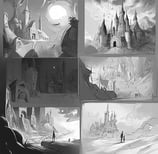

5 Frame
A five-frame storyboard breaks down a scene into its most essential moments, capturing key actions, transitions, and emotions. It's a concise visual tool that helps communicate the flow of a story while focusing on pivotal elements like character interactions, setting, and movement. This format is ideal for quickly visualizing ideas and refining the pacing of a sequence.

Black and white
Black-and-white storyboards emphasize clarity and focus by stripping away distractions like color. The contrast between light and dark highlights important details like action, framing, and mood. This style is both efficient and effective, allowing teams to visualize the narrative while leaving room for creative interpretation during later stages.

Scripts
Storyboards often work hand-in-hand with scripts, translating written dialogue and stage directions into visual sequences. Scripts provide the foundation for timing, action, and scene transitions, ensuring the storyboard aligns with the narrative's tone and pace. This combination bridges the gap between concept and execution.

Film
Film storyboards are crafted to visualize cinematic moments, capturing camera angles, lighting, and key movements. They help directors, cinematographers, and production teams plan complex sequences, ensuring a smooth workflow on set. Each frame serves as a guide for storytelling, visual effects, and overall composition.

Animation
Animation storyboards focus on timing, character motion, and scene transitions, serving as the blueprint for the animation process. Each frame illustrates key poses and movements, along with visual cues for effects, expressions, and camera shifts. This stage is crucial for pacing and narrative flow in animated projects.

Commercials
Storyboards for commercials are designed to convey a clear and engaging message in a short timeframe. They map out visual elements, product placements, and key moments, ensuring that the commercial captures attention while effectively communicating its core idea to the audience.

Books
Storyboarding for books focuses on visually mapping out key scenes or chapters, especially for graphic novels or illustrated stories. It helps authors and illustrators align on layouts, pacing, and panel transitions, ensuring the visual narrative enhances the text.

Music Video
Music video storyboards translate audio into a visual journey, syncing key beats with actions, cuts, and effects. They often feature dynamic camera angles, lighting notes, and movement cues, ensuring the visuals align with the rhythm and emotion of the music, creating a seamless experience.





